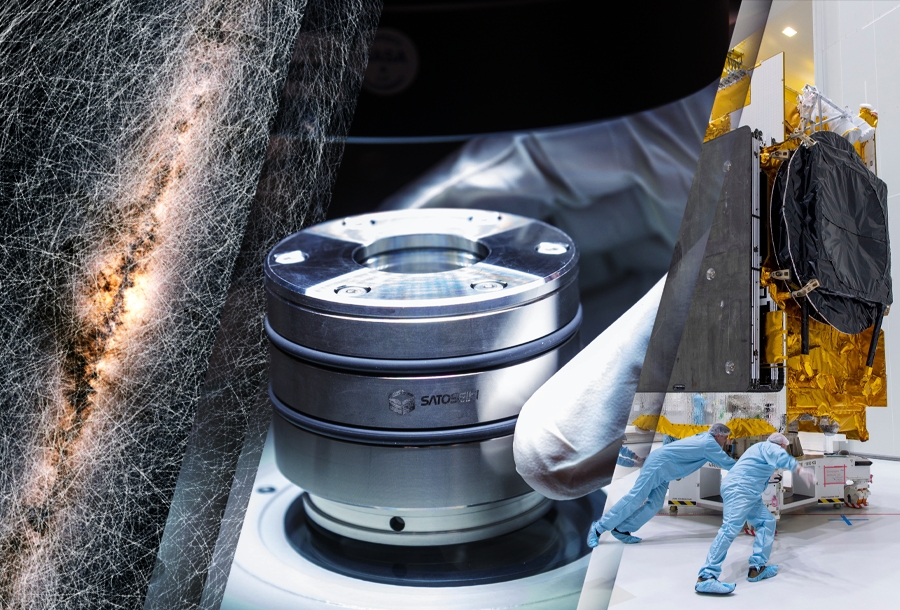Selection of the most interesting space news for breakfast: The modern “airship” Sceye will spend several months in the stratosphere using only renewable energy sources. The OSIRIS-REx spacecraft is observing the ‘body armor’ of the asteroid Bennu, and we are talking about the classification of black holes.

NASA spacecraft observes asteroid Bennu’s boulder ‘body armor’
Asteroid Bennu’s boulder-covered surface gives it protection against small meteoroid impacts, according to observations of craters by NASA’s OSIRIS-REx (Origins, Spectral Interpretation, Resource Identification, Security-Regolith Explorer) spacecraft. “These observations give new insight into how asteroids like Bennu respond to energetic impacts,” said Edward (Beau) Bierhaus of Lockheed Martin Space, Littleton, Colorado.
SpaceX to launch 3 rockets from 3 pads in 3 days this weekend
The private spaceflight company aims to launch three rockets from three different launch pads in three days starting on Friday (June 17), when SpaceX will loft 53 Starlink internet satellites into orbit from Pad 39A of NASA’s Kennedy Space Center in Florida. A launch from California’s Vandenberg Space Force Base will follow on Saturday morning to orbit a radar satellite for the German military, with the third mission returning to Florida to launch a commercial communications satellite from Cape Canaveral Space Force Station.
Market News
Sceye HAPS Ascend to Stratosphere Using Renewable Energy Sources
Sceye, a manufacturer of High-Altitude Platform Stations (HAPS), announced today that it reached the stratosphere with the aim of demonstrating the ability to stay over an area of operation for months at a time using renewable energy sources. The milestone test launch, which is using patented solar and battery power, puts Sceye on track to expand internet access to remote populations, monitor greenhouse gasses down to individual emitters, and detect natural disasters as they begin. The company also announced additional test flights for Q3 and Q4 2022.
Euroconsult anticipates growing demand for last-mile logistics
Euroconsult forecasts 120 orbital transport vehicles to be in operation by 2031, according to the consulting firm’s latest Space Logistics Markets report.
“We anticipate constellations to be the most likely customers, accounting for three-quarters of the demand for satellites in the 200- to 350-kilogram mass range,” said Maxime Puteaux, Euroconsult principal advisor and author of the report released in May.
Getting SSA off the ground
Keeping close tabs on satellites and their increasingly crowded orbits requires exquisite spatial data that multiple startups say can only be gained from space.
At least eight early-stage companies in North America, Europe, and Australia have secured funds for space-based systems they say will be needed to provide more accurate, complete and reliable information about objects in space. Some envisage deploying hundreds of dedicated space situational awareness (SSA) satellites, whereas others opt to deploy their sensors on third-party spacecraft.
Quadsat gets ESA funding for ready-to-fly antenna testing kits
Danish startup Quadsat said it has secured European Space Agency funding to productize the drones it uses to calibrate and test satellite antennas.
Quadsat CEO Joakim Espeland said that at the end of the 10-month ESA contract worth 500 thousand euros (525 thousand US dollars), the company intends to launch its first drone, which customers will be able to control themselves to test their networks. Quadsat currently has to send technicians to the customers that want to use its quadcopters as stand-ins for satellites.
Senate Armed Services Committee proposes $45 billion funding boost for DoD
The Senate Armed Services Committee voted 23-3 to advance its version of the 2023 National Defense Authorization Act. According to a summary released by the committee, the bill authorizes $817.3 billion for the Department of Defense, a nearly $45 billion increase above the Biden administration’s request of $773 billion. The SASC proposal now heads to the Senate floor for consideration.
Airbus built MEASAT-3d communications satellite ready for launch
The Airbus built MEASAT-3d telecommunications satellite is in Kourou, French Guiana and is ready for its launch on an Ariane 5 on 22 June 2022.
MEASAT-3d is the 57th E3000 satellite built by Airbus and will be positioned at the 91.5E orbital slot and collocated with MEASAT-3b, also built by Airbus.
Interesting

“Multicolored ” black holes (article)
The phrase “black hole” has long and firmly established in our languages, although it has been widely used for not so long — since half a century ago when this word combination was adopted by the American physicist John Archibald Wheeler for his popular science lectures, while in fact it was not him who coined this term.
NASA assigns 2 astronauts to fly on Boeing Starliner’s 1st crewed mission
NASA astronauts Barry “Butch” Wilmore and Suni Williams will fly on Crew Flight Test (CFT), Starliner’s first crewed mission to the International Space Station, the agency announced today. Wilmore will command the mission, with Williams serving as pilot and fellow NASA astronaut Mike Fincke training as backup pilot.
Follow us on Twitter to get the most interesting space news in time
https://twitter.com/ust_magazine

